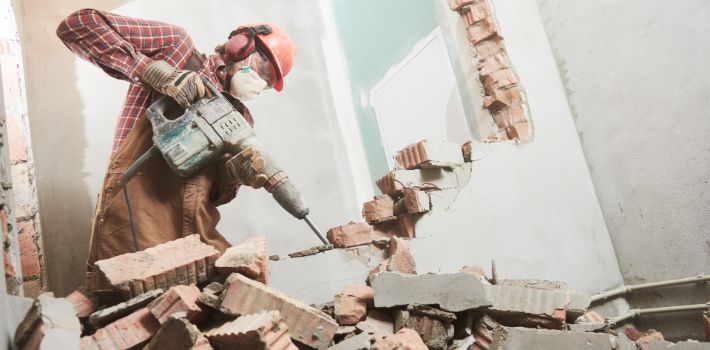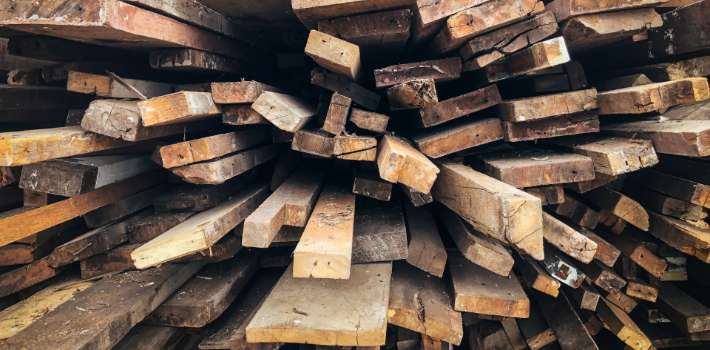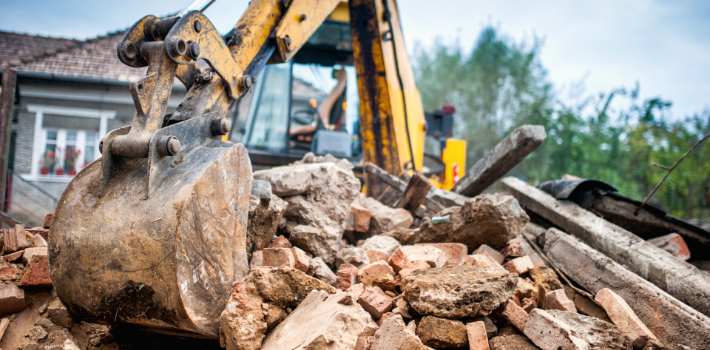House Demolition: How Much Does It Cost?
While you might associate demolitions with wrecking balls swinging to devastating effect or sticks of gelignite scattered liberally around a building- in reality, a successful demolition requires precision, and plenty of consideration and forward planning, especially if you don’t want to topple your budget.
To help you through the process, we’ve compiled a list of some of the factors you may want to consider.
How much does it cost to demolish a house?
The cost of a total demolition depends on a variety of factors and the price range can vary significantly, with the average price being approximately $15,000. Sydney-based Paul’s Rubbish Removal estimates that the average cost of demolishing a house in Sydney can be as low as $10,000 or be as much as $80,000. The cost can also vary depending on where in Australia you are. For example, Paul’s Rubbish Removal estimates the cost for similar work in the ACT to be somewhere between $30,000 and $50,000.
According to insurance advisor LMI Group, the estimated cost per square metre for demolition work in some of Australia’s major cities is currently as follows:
- Perth – $40/m2 for a brick home or $35/m2 for a home with a wooden frame
- Brisbane – $46/m2 for a brick home or $40/m2 for a home with a wooden frame
- Adelaide – $47/m2 for a brick home or $39/m2 for a home with a wooden frame
- Melbourne and Hobart – $54/m2 for a brick home or $40/m2 for a home with a wooden frame
- Sydney – $64/m2 for a brick home or $53/m2 for a home with a wooden frame
Additionally, online trade-sourcing platform Oneflare says manual deconstruction is approximately double the price of the selective or total demolition methods as it is generally more labour-intensive.
What are some common types of demolition?
There are generally three common methods for demolishing a house, depending on what you require.
Selective or part demolition
This type of demolition could include jobs where a homeowner wishes to remove only part of the building, such as the interior of a structure or an individual wall, without compromising the structure of the home. It can also be an attractive option for homeowners who may be required by council regulations to keep the exterior or facade of the building intact but wish to tear down other parts of the home. This type of demolition is generally more labour-intensive and may not rely as heavily on machinery as other alternatives.

Total demolition
A total demolition refers to the demolition of an entire structure or building. Due to the nature of the work involved, this type of demolition usually requires heavy machinery, such as excavators and dump trucks. Jobs like this are often charged by the hour, with the cost typically covering the equipment and labour required on the day, as well as any planning and site assessments your chosen provider may need to carry out in advance.
Manual deconstruction
Manual deconstruction typically involves identifying all salvageable and recyclable materials within the building before demolition begins. These materials are then removed separately and recycled, reused or sold, with the intention of reducing waste. According to, Melbourne-based sustainable demolition company EcoGroup, this method creates considerably less landfill than demolition and considers it the most eco-friendly option.
What factors may determine the cost of a demolition?
Some factors that can impact the total cost of your demolition job may be:
How big is the property?
The size of the home or structure to be demolished will affect the cost of the job. Bigger demolitions generally require more labour, time and equipment. Additionally, if you’re hiring professionals to do the work, many contractors charge by the square metre, so the size of the building can be crucial in determining the job’s overall cost.
What is being demolished?
Whether you require a total or partial demolition, and whether the demolition is interior or exterior will determine the method of demolition required and influence the total cost of the work. For example, Oneflare estimates that the demolition of an interior non-load-bearing wall could set you back a minimum of $1,500. On the other hand, it estimates that a load-bearing, or structurally important, wall could cost upwards of of $4,500 to demolish.
If necessary, the cost of removing other structures from your property such as tennis courts, carports or free-standing buildings like sheds should also be factored in. Consider too that trees and shrubs on your property may also be potential obstacles for your demolition crew and may need to be cleared or removed prior at an added cost.
What material is the house made from?
The materials involved will generally impact the overall cost of the job as this usually helps determine the method of demolition and what tools will be used. For example, a timber house can be completely demolished for about $10,000, according to Able Earthmoving and Demolition. Timber can also sometimes be salvaged and reused, which may save you some money further down the track if you plan to rebuild or renovate.

Concrete, bricks and cement, on the other hand, are generally more expensive materials to demolish, as they require heavier machinery and equipment, such as a jackhammer. These heavier materials may also take longer to demolish, which could increase the cost of the job, but like timber, they may also be recyclable.
Is your property accessible?
How accessible your property is, as well as its general location, can also be determining factors of a contractor’s quote and preferred method of demolition. The site’s gradient and access points will be particularly important if the job requires machinery. Your location may mean that a contractor will charge you for their travel and the transport costs for tools and equipment. The distance from your home to the nearest recycling and disposal facilities may also influence the cost of your demolition.
Are any of the building’s materials hazardous?
If you need to remove and dispose of any hazardous materials, this will most likely increase the cost of your demolition. This is because of the added precautions, requirements and risk that this will likely involve for your contractors.
Materials such as mould, mineral fibres and asbestos are all typically fairly expensive to remove, as Australian law requires the use of specialised equipment and for additional safety measures and procedures to be followed. Removal and disposal of asbestos must be done by a qualified professional as current Work Health and Safety Regulations provide that asbestos must not be handled without training and a current licence to do so. Mould is expensive to remove as it also requires specialist treatment and removal during a demolition.
National building company, G.J. Gardner Homes, says that asbestos is three times more expensive to remove than non-hazardous building materials, while Able Earthmoving and Demolition estimates that the typical removal costs of asbestos from a standard house in Brisbane come in at around $2,500.
In addition to the expensive labour costs of removing hazardous materials, New South Wales-based business Home Demolitions says they are around three times more expensive than standard materials to dispose of safely.
Do you need a planning permit to demolish a house?
Depending on your proposed demolition and the state requirements that apply, you may need to apply for a planning permit in order to proceed.
Many of these state requirements are designed to preserve heritage-listed properties and to ensure that city planning is consistent. In some areas, if the demolition work meets certain requirements, you may not need planning approval.
On the other hand, depending on your location, a planning permit may be required in bushfire-prone areas.
If you do need to apply for a permit, Oneflare says that you will likely need to include the following supporting details:
- Marked site plans and photographs that clearly show the to-be-demolished buildings and their surrounds.
- A description of the demolition and your plans for the protection of surrounding properties.
- The title or deed for the land, which is the proof of who owns of the property. You can request an official copy from your state government or an approved distributor, such as Landata, for around $20 to $30.
- The approved demolisher or contractor you’ll be using, including their registration, insurance details and public liability insurance policy.
- The procedures you’ll take to dispose of any waste that results from the demolition.
Generally, your contractor should be able to assist you with any permit applications and enquiries, however this may come at an additional cost.

What steps should you follow before demolition?
Before the demolition begins, you may need to consider the following:
- Choosing your contractor: As is the case with any building or renovation job, your choice of contractor could be the difference between a smooth job or one beset by complications. When considering a contractor, ensure that they have the appropriate licences and qualifications required.
- Obtaining a permit or other approval: As mentioned above, before the demolition begins you may need to receive approval from your local council or a planning permit to continue…
This article is from Canstar, you can read the full article here:

Photo by Ruslan Khadyev on Unsplash
